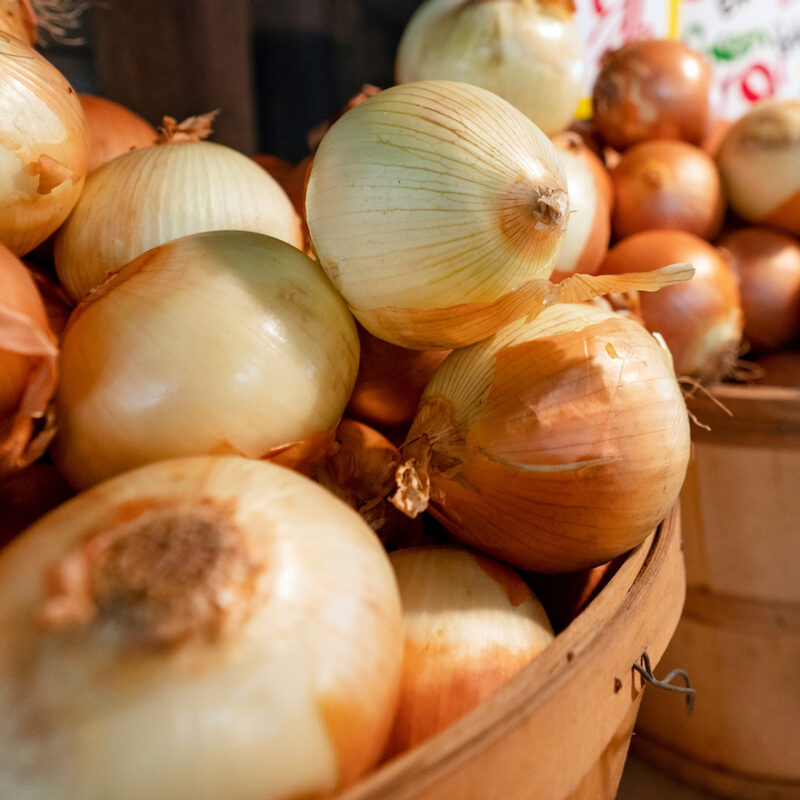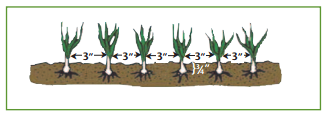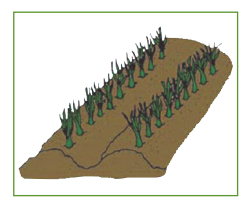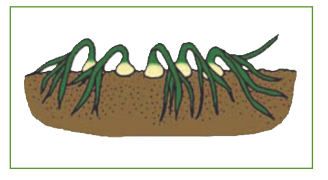Onions
By: Joseph Masabni

Yellow, white, and red/purple onions grow very well in Texas home gardens. Green onions may be eaten fresh or chopped and added to salads. Bulb onions may be sliced and used on sandwiches or dipped in batter and fried as onion rings. Although onions are a source of vitamins A and C, they are used mostly as a flavoring in other food dishes.
Varieties
The varieties of onions that grow best in Texas are listed below.
Table 1. Short day (11-12-hour day length)
| Color | Varieties |
|---|---|
| Yellow | Chula Vista, Cougar, Jaguar, Legend, Linda Vista, Mercedes, Prowler, Safari, Sweet Sunrise, TX 1015Y, Early Grano 502, Granex |
| White | Cirrus, Marquesa, TX Early White, Crystal Wax |
| Red | Red Bone, Rio Santiago, Sakata Red, Red Burgandy |
Table 2. Intermediate day (12-13-hour day length)
| Color | Varieties |
|---|---|
| Yellow | Caballero, Cimarron, Riviera, Utopia, Yula |
| White | Alabaster, Mid Star, Sierra Blanca, Spano |
| Red | Fuego |
Table 3. Long day (14-16-hour day length)
| Color | Varieties |
|---|---|
| Yellow | Armada, Capri, Durango, El Charo, Ole, Seville, Sweet Perfection, Valdez, Vaquero, Vega |
| White | Blanco Duro, Sterling, White Spanish Sweet |
| Red | Tango |
Site selection
Onions grow best in full sunlight and well-drained soils.
Soil preparation
Work the garden soil only when it is dry enough not to stick to garden tools. Before seeding or transplanting, work the soil 8 to 10 inches deep.
Remove all rocks and trash from the soil; then break up the remaining clods and rake the soil smooth.
Planting
Onions are a cool-season crop and can stand temperatures well below freezing. They may be planted from seeds, from small bulbs called sets, or from transplants.
Seeding costs the least but takes longer before onions are ready. When seeding onions for bulbs, plant them ¼ inch deep during October through December. Place the seeds 1 inch apart. When the plants are about 6 inches high, thin them to one plant every 2 to 3 inches. Eat the extra plants as green onions.

If you use sets or transplants, plant them ¾ inch deep and 3 inches apart (Fig. 1). Do not transplant onions more than 1 inch deep.
Fertilizing
Onions grow best when the garden soil is fertilized correctly. Spread 2 to 3 pounds of a fertilizer such as 10-10-10 over a 100-square-feet of garden area. Measure and spread the fertilizer; then mix it with the top 3 to 4 inches of soil.
Watering
Watering once a week usually is enough in the spring. But you may need to water more often during dry, windy weather. Water onions slowly and deeply to help grow strong, healthy roots.
Care during the season
Weeds are easy to pull or cut when they are 3 to 4 inches tall. Do not let weeds or grasses grow large because they compete with onions for nutrients.
If you use a hoe to remove weeds and grass, do not chop too deeply. You may be cutting the onion roots. Pull all weeds by hand when possible.

When the onion plants have 5 to 6 leaves, apply fertilizer again to help grow larger plants and bigger bulbs (Fig. 2). Each leaf forms a ring in the onion bulb. More leaves means more rings and larger bulbs.
Use about ½ cup of fertilizer for each 10 feet of onion row. Scatter the fertilizer evenly between the rows. Water the onions after adding the fertilizer.
Insects
Onions have few insect problems. However, thrips, which are very tiny insects, may be found between the center leaves.
Many insecticides are available at garden centers for homeowner use. Sevin is a synthetic insecticide; organic options include sulfur and Bt-based insecticides.
Diseases
Diseases may be a problem on onions. Brown leaf tips or brown spots on the middle and lower parts of leaves may be caused by plant diseases.
Sulfur also has fungicidal properties and helps control many diseases. Neem oil and other fungicides are also available for use.
Before using a pesticide, read the product label. Always follow cautions, warnings, and directions.
Harvesting
Onions seeded in October/December or transplanted in January/February should produce bulbs in May/July.
If used as green onions, they may be picked from the time they are pencil size until they begin to form bulbs.

For dry-bulb onions, let the plants grow larger. The onions are ready when the main stem begins to get weak and fall (Fig. 3). Pull the plants out of the soil.
Leave them lying in the garden for 1 to 2 days to dry. Then remove the tops and roots and let them keep drying in baskets or boxes.
Storing
Store onions in a refrigerator crisper or in a dry, airy place such as in a wire net in the garage or carport.
Download a printer-friendly version of this page: Onions
View this publication in Spanish: Cómo cultivar cebollas
Download the Growing Onions Guide: Onion Growing Guide
